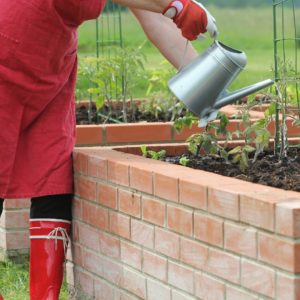At Glover Nursery we are dedicated to helping you achieve your garden goals. We love to answer your questions and set you up for success with the best plants and garden supplies. Recently, we’ve received a few questions from you all about raised garden beds: what are they, how do I make one, what are the benefits, and how can I make sure it’s successful? We want to answer all of your raised bed questions right now!
What Is A Raised Garden Bed?

Raised bed gardening is a type of gardening in which the soil is lifted above ground level and enclosed. The structures for raised beds, a platform with four walls or garden boxes, can be constructed out of a variety of materials, some of the most common are wood, rock, or concrete. They can be made in any size that works for you and your space. From small patio gardens to large backyard spreads, raised beds are a great option.
The soil in a raised bed is typically enriched with compost. Personally, we suggest Rich and Complete; it is a fabulous blend with all the nutrients needed for your flowers, veggies and herbs.
What Is The History of Raised Garden Beds?

Raised garden beds can be dated back to medieval times when farmers would use walls made of woven limbs and branches – wattle fences – to keep their gardens contained. Fast forward to the 18th century when Parisian gardeners would use horse manure to grow vegetables to sell at the market. In the 1970s this way of gardening was appealing to smaller-scale home gardeners because of the higher yield.
What Can You Grow In A Raised Garden Bed?
When it comes to raised garden beds you can grow a wide selection of different plants. Some of the most common to grow are annual flowers, veggies or herbs. What works best for your setup will depend on how much sunlight the raised bed receives – but more often than not, you will have raised beds in mostly sunny areas. Some common things to grow in raised beds are Tomatoes, Peppers, Lettuce, Squash or small fruits like Raspberries or Strawberries. But, in reality, there is no limit to what you can grow. Maybe you use your raised beds for an amazing floral garden for cutting flowers like Peony, Coneflower, Poppies, Lavender or Foxglove.
Pro Tip: Use trellises for plants like peas that like to crawl.
Another useful link: Learn about Setting Your Veggie Beds Up For Success Garden
What Are The Benefits of a Raised Garden Bed?
 An elevated garden bed is beneficial for a number of reasons – both for you and your plants. First, raising the garden above ground level makes bending over and working on your garden less of a strain on your body. You can build them as tall as you need – as long as you can fill it with soil.
An elevated garden bed is beneficial for a number of reasons – both for you and your plants. First, raising the garden above ground level makes bending over and working on your garden less of a strain on your body. You can build them as tall as you need – as long as you can fill it with soil.
A raised bed also isolates your plants and helps prevent weeds and pests. The soil will also be more aerated and have better drainage.
Raised garden beds allow for a longer growing season because they warm up quicker in the spring, and cool down slower in the fall. You can also cover them with plastic stretched over hoops as the weather gets colder and create a little mini greenhouse.
You may also read: Cost Effective Veggies For Your Garden
How Can I Create a Raised Garden Bed?

Many people choose to build their raised garden beds themselves with treated 2 x 4s or retainer wall materials. If you are crafty, building raised beds could be a fun weekend project. There are a few places that provide raised garden bed kits, such as SilverCreek Garden Boxes. You can also order a kit from Vego Garden for a more modular look that is easy to move and adapt to an area if you want to try a few options out.
Let us know in the comments if you plan to start a raised bed this spring! If you already have one – tell us your favorite thing to grow. If you’d like to join an ever-growing online garden community for both beginners and seasoned gardeners alike, come say hello in our Glover Nursery Gardening Group. The community is always sharing their garden wins and gardening tips.

